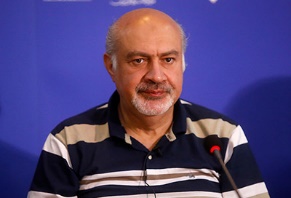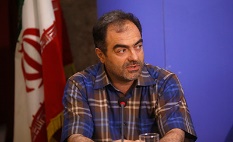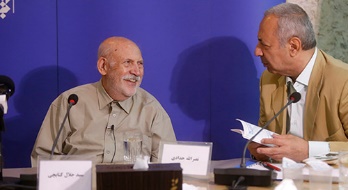Interviewing with Jalal, Farid, and Mohammad Bagher Ketabchi in the meeting of "oral history of book."
"The Ketabchis" and their book stories
Maryam Rajabi
Tyranslated by Zahra Hosseinian
2017-6-6
From right: Nasrallah Haddadi, Jalal, Farid, and Mohammad Bagher Ketabchi
According to the Oral History website, the fifth sessions of the second round of meetings of "oral history of book" was held on Tuesday evening, 23rd May 2017, in the house of Literati of the Iran book house, with the presence of Nasrallah Haddadi, as an expert and announcer, Seyyed Jalal Ketabchi, manager of Islamiyah publishing, Seyyed Farid Ketabchi and Seyyed Mohammad Bagher Ketabchi, managers of Elmiyeh Islamiyah publishing.
"I am the son of Seyyed Ahmad Ketabchi and was born on 30th June, 1938 in Tehran." Seyyed Jalal Ketabchi began the meeting and introduced himself, "My grandfather, Mir Mohammad Ketabchi lived in Shiraz, but came to Tehran. My father was born in Tehran and didn’t go to the Shiraz even once. At that time, books were imported through India and sent to Shiraz which was the cultural center and seminary. I spent the first grade in Toufiq elementary school which was located in Siroos intersection. I studied second to sixth grade in Mohammadi School whose principal was the late Jarollahi and which was in fact an Islamic school. I studied the seventh to the eleventh year in Marvi high school and one year in Tamadon high school which was located in the Istanbul street. I went to the institute of religious sciences one year and benefited of the presence of some masters, such as Dr. Sahabi and Bazargan."
"I was born on 18th April, 1961. Seyyed Jalal Ketabchi is my uncle and I am the third generation of the family. I studied engineering, but due to my father and uncle’s aging, I’ve turned to this job." Seyyed Farid Ketabchi said.
"I am the son of Seyyed Morteza Ketabchi and was born on 28th June, 1962. I’m the fifth generation of the family." Seyyed Mohammad Bagher Ketabchi said.
Following the meeting, Seyyed Jala Ketabchi added: "At the time of Reza Shah, due to the destruction of part of NaserKhosro Street and building department of finance, we moved to a street which is now called 15Khordad, without receiving any compensation. My father bought a house in this street and built a three-floor building for our warehouse, shop, and office. I began working in printing industry in 1956. Our printing house was in the vicinity of our shop in 15Khordad Street. The lithography machines existed from my father’s time. Printing with them was very slow. Ten workers with a machine during ten hours, could prepare three plates each which was used 500 times and the final work per shift was 1500. Because it was not economical, we didn’t use the machines anymore and with the help of my brother, Seyyed Ismail, who was in charge of running the library after our late father, we purchased new machines from Nouriyani institute. These machines printed characters and clichés. A few years later, offset devices appeared in the markets and we bought them from the same institution. At first, we had five printing machines, but decreased to one due to lack of work. The previous year we deactivated that too. Next to the printing house we had a shopping center and we had dedicated the top floor of it to the binding. Twenty workers worked in this sector and binding of each book [edition] took about six months."
Islamiyah brand and working with figures
At the fifth session of the second meeting of "oral history of book", Seyyed Farid Ketabchi pointed out, "Islamiyah brand was recorded in 1901. Before that, our ancestors worked with the name of ‘Ketabchi’, but they didn’t have the Islamiyah brand."
In this regard Mohammad Bagher Ketabchi explained: "at first our family name was ‘Mousavi’, then it changed to ‘Islamiyah’, ‘Akhavan Ketabchi’, and finally ‘Ketabchi’."
Seyyed Jalal Ketabchi noted the celebrities in the field of culture, who worked with Islamiyah publishing, such as: "Late Sha'rani, Haji Bagher Kamarehii, Mohammad Bagher Behboodi, Mohammad Javad Najafi, Safiallh Mahalati, Seyyed Hashem Rasooli, and AbdulRahim Shirazi. The author’s fee contract between us and these ones was quite verbal and even some like, Sheikh Abbas Qomi, wouldn’t receive any fees; because he only considered spirituality for doing a work. People like the late Sha'rani even didn’t look at inside the fee’s envelope."

Considering the financial situation and needs of customers
He also pointed out, "Most of our books were religious, because our religious orientation and family training was on this side. On the other hand, given the kind of books, our customers were most Ulema, seminary students or university students who not be able to afford and we wanted the price of books to be affordable for them. Later, we also published several books in the field of Quranic stories, sociology, Islamic medicine, and law. According to our customers' demands, we published civil rights by Hassan Emami, which has been reprinted 36 times from 1957 to today. We sold our books by pre-sales bills. We took 10 Tomans from customer to be shared in publishing the book, for example, and gave the first volume free to be required to buy the rest of books."
About reasonable price of books in this publication, Seyyed Farid Ketabchi also said: "most of the time we considered the spiritual dimension of work. For pricing books, my father didn’t consider the free market and calculated on the basis of the price which had been specified by the ministry of Islamic guidance. In the field of selling, we first sold books which had been priced and then those which hadn’t been priced; so that, if we wanted to update the prices because of the effect of inflation, there was no difficulty. We don’t have printing process and before me all works has been done and we only reprint. On the other hand, people was more careful about the content in the past, but nowadays printing, binding, and the appearance of the book has been very important for them, and has great influence on buying."

Efforts for completing the publication of Shiite Encyclopedia
Seyyed Jalal Ketabchi added: "the late Akhundi published 110-volume Bihar al-Anwar very slowly, so that thirty volumes were published in thirty years. When customers complained about the slowness of its publishing, my late brother along with Mohammad Bagher Behboodi and AliAkbar Ghaffari made a move to publish it, according to lithography print of some of volumes and manuscripts which were exist in the libraries. We published from volume-43 onwards, but it was done with the agreement of Akhundi, and in fact it was not only competitive, but friendly. Because it was the issue of completion of a massive Shiite encyclopedia, and even ayatollah Khersan in Najaf corrected a few volumes of Bihar al-Anwar. We had a few special warehouses for maintenance of Bihar al-Anwar books and the home of late Modarres also was available. Although the typesetting was very hard, but we printed 110-volume Bihar al-Anwar, 12-volume Tafsīr Abū al- Futūḥ Razi, 6-volume Tafsir Safi, Menhaj Al-Sadeghin, Nāsikh al-tawārikh, and Wasā'il al-Shīʿa."
About the home of Ayatollah Seyyed Hassan Modarres, he explained: "I was ten years old when my father bought here. I lived with my parents and four brothers. Each of my brothers who got married, two rooms of our house were provided for them. The architecture of our house allowed families live together while each of them have had their own independency. Our house had three doors, so no one disturbed others. The house was located at the end of a narrow alley, and became impassable in winter and snowy weather; therefore, in fall, we transferred a number of books to the house on 15-Khordad Street."
In response to announcer’s question about branching Islamiyah publishing from ‘Elmiyeh Islamiyah’, Seyyed Jalal Ketabchi said: "The name of our bookstore at the time of my father and uncle was ‘Elmiyeh Islamiyah’. Later, due to destruction of part of NaserKhosro Street for building property organization, our bookstore was moved to a street which is named 15Khordad now. My uncle established another branch in the precinct of holy shrine of Masoumeh (AS) and named ‘Elmiyeh Islamiyah’, and we chose the name of ‘Islamiyah’. Then my brother, Seyyed Mohammad, set up another branch and separated from us, and chose the name of ‘Ketabchi’ for his publishing."
Unforgettable events
About others’ exploitations from their works, Seyyed Mohammad Bagher Ketabchi explained, "a person who had a water pump shop in Sa’adi Street, complained about the high price of books. And since he had not enough funds to perform his idea, collected money by help of benefactors and chose to publish high edition of our Usul al-Kafi book which was translated by late Mostafavi. We disappointed. Unfortunately, the Ministry of Culture and the syndicate didn’t have much authority to stop these exploitations."
Seyyed Farid Ketabchi also said, "One of discouraging factors is that we are not safe in our job. Sometimes, the works which accompany great difficulty and four times edition, typesetting, performing diacritic marks, and calligraphy, are easily plagirized and published."
About Quran books in this publishing, he explained: "We have seven Qurans differs in calligraphy, translation, and format. The late calligraphist Tahir who was an erudite man, performed calligraphy of the Qur'an; and the editions was done by late Sha'rani. When the ministry of guidance checked our Quran, found only three or five wrongs in diacritics marks, according to their own criteria. One of well-received Qurans was the one Mrs. Ranjbar had performed its calligraphy. She was one of good teachers who taught children and women. She used her own way for performing diacritic marks in this Pakistani Quran. After a few release, she asked to publish the same Quran with Iranian script. The Quran which was translated by late Moezi was also literal and mostly students bought it."
Seyyed Farid Ketabchi also added: "Today, by publishing the Qurans with script of Osman Taha, the Iranian ones have been set aside. That time, due to legibility of Tahir’s script, we worked with him and my father edited the diacritics marks."
Seyyed Jalal Ketabchi named the bookstores of 15-Khordad Street: "Khazar, Ja’afari, Beirut, Mostafavi, jahan, and Elmi. In Sultani market, there were also Akhundi, Lotfi, Elmi brothers, Amir Kabir, and Shams Farahani."
About dictionaries, he said: "We have different dictionaries, including English to Persian and Arabic to Persian. To publish Arabic to Persian dictionary, we used the Beirut copy of Arabic to Arabic and instead of Arabic translation, we used their Persian equivalents. We considered the religious aspects and didn’t offset other copies."
Seyyed Jalal Ketabchi continued: "We had 300 dealers in various cities during the flourish of book market before the revolution, including Danesh and Ferdowsi bookstores in Mashhad, Dar al-Ketab and Dar al-Elm in Qom, Hashemi and Ma’arefat in Shiraz, Saghafi and Torshizi in Isfahan. We posted the books, if the list of orders was low; and if it was many, we first packed the books in the egg boxes, and then in cartons and sent them. To settle an account, we received a draft. We advertised in newspaper when a new book was released and also prepared manual ads and sent them to our dealers in other cities."
"From the beginning I was one of syndicate members and it wasn’t ineffective; but I couldn’t stop plagiarism." He added.
Seyyed Jalal Ketabchi also noted days when SAVAK was notified about the publication of Volume-28 Bihar al-Anwar.
At the end, Mohammad Bagher Ketabchi mentioned that one of problems in publishing is compiling books which divests people of trust in books; because in this way the book will be manipulated and it has no authenticity any more.
The first session of the new round of "oral history of book" meetings has been held on Wednesday, 15th April 2017 with the presence of Haj Baitullah Radkhah (Moshama’achi), manager of Tehran-Tabriz publication; the second session on Wednesday, 19th April with presence of Jamshid Ismailian, manager of Partow publication; the third session on Wednesday, 26th April with the presence of Abolghasem Ashrafalkotabi, manager of Ashrafi; and the fourth session on Wednesday, 17th May with the presence of Hojjat al-Eslam Buick Cheetchian, manager of Mortazavi publication.
With efforts of Nasrallah Haddadi, the first meeting of "oral history of book" was also held during the second half of 1393 until the summer of 1394 in the house of Literati of the Iran book house. The result of these meetings has been published in a 560-page book, titled oral history of book, by the Book House Institute.
Number of Visits: 6074








The latest
- Third Regiment: Memoirs of an Iraqi Prisoner of War Doctor – 8
- 100 Questions/7
- Managing Oral History Interviews
- The 372nd Night of Memories – Part 1
- Third Regiment: Memoirs of an Iraqi Prisoner of War Doctor – 7
- Objects Tell What Happened in the Eight-Year War!
- 100 Questions/6
- Comparative Analysis of Women’s and Men’s Written Memoirs in the Sacred Defense
Most visited
- Third Regiment: Memoirs of an Iraqi Prisoner of War Doctor – 6
- Third Regiment: Memoirs of an Iraqi Prisoner of War Doctor – 7
- Comparative Analysis of Women’s and Men’s Written Memoirs in the Sacred Defense
- 100 Questions/6
- Objects Tell What Happened in the Eight-Year War!
- The Importance of Pre-Publication Critique of Oral History Works
- The 372nd Night of Memories – Part 1
- Managing Oral History Interviews
Comparing the Narratives of Commanders and Ordinary Combatants in the Sacred Defense
An Analysis of Functions and ConsequencesThe experience of the Sacred Defense cannot be comprehended merely through statistics or official reports; what truly endures from war are the narratives of those who stood upon its frontlines. These narratives, however, vary significantly depending on one’s position, responsibilities, and lived experience.
Unveiling of the book "Oral History: What and Why"
The First report: Alireza KamariAccording to the Oral History website, the unveiling ceremony of the book "Oral History: What and Why" by Hamid Qazvini was held on Sunday evening, November 24, 1404, in the presence of experts in the field of oral history in the Salman Farsi Hall of the Arts Center.
Mohammad — The Messiah of Kurdistan
Boroujerdi immediately said to Darvish, “Ready a few men; we’re going.” Then he moved toward Mostafa, who was studying the Kurdistan map. Mostafa straightened his back and said, “During my service in the army I experienced a full-scale war in Kurdistan. Guerrilla warfare in Kurdistan follows its own rules. The anti-revolutionary commanders want to draw us into a battle chosen on their terms.”


